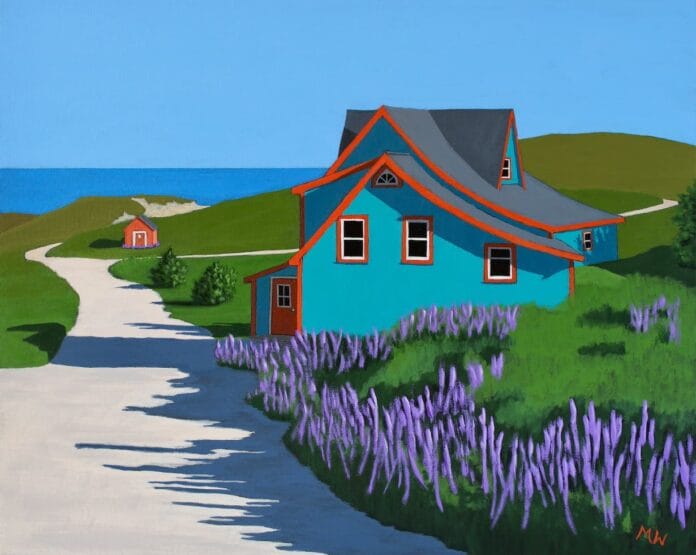Michelina Williamson’s artistic journey has been defined by transformation, exploration, and a deep search for authentic expression. Born with a natural creative impulse, Williamson initially pursued her interest in visual storytelling through film. She graduated from the Ontario College of Art’s New Media program in 1991, where she embraced experimental filmmaking as a medium of discovery and innovation. Her work during this period was exhibited in Toronto, Montreal, and Germany, gaining recognition for its fresh approach to new media art.
However, as technology advanced and the digital process became more prevalent, Williamson began to sense a growing disconnect. The virtual and often detached qualities of filmmaking left her yearning for something more direct, tactile, and personal. This search for a deeper connection led her back to university, where she obtained a Bachelor of Fine Arts degree in 2010. Soon after, in 2011, she shifted her focus to painting, embarking on a new chapter in her creative journey.
A Turning Point: From Digital to Tactile
The move to painting marked both a necessary and liberating transition. Williamson found that the immediacy of brush to canvas brought greater meaning to her work by creating a physical and emotional connection. Unlike film, which is mediated through layers of editing and technology, painting offered her an unfiltered experience of presence. Each brushstroke carried weight, presence, and emotion, allowing her to engage with art in a more visceral way.
Artistic Influences and Inspirations
Like many artists who forge a unique path, Williamson draws strength from those who came before her. Among her most significant influences are Georgia O’Keeffe, Carmen Herrera, and Doris McCarthy.
O’Keeffe’s bold exploration of nature’s forms resonates deeply with Williamson’s own landscape practice, while Herrera’s disciplined abstraction and mastery of colour echo in her refined yet emotive compositions. McCarthy’s lifelong devotion to Canadian landscapes also provides inspiration, grounding Williamson’s own exploration of place and memory.
What unites these influences is their ability to balance structure with freedom, a quality that Williamson carries into her own work. She merges thoughtful colour and compositional choices with the intuitive, expressive qualities of paint application. This balance allows her to strip a subject down to its essentials and, at the same time, infuse it with emotional resonance.
Exploring the Human Connection to Nature
At the core of Williamson’s painting practice lies a deep engagement with the relationship between humans and the natural world. Through landscape, she explores not only the beauty of the environment but also the emotions it holds and the emotions we project onto it.
Her works reveal places not just as physical spaces, but as carriers of memory, feeling, and spirit. A shoreline, a stretch of forest, or the shifting horizon becomes more than an image; it becomes a conversation between the outer world and the inner life of the viewer.
She adopts a minimalist approach, reducing a scene or subject to only what feels necessary. Into this distilled composition she infuses rich, bold colours, creating a powerful contrast between simplicity of form and intensity of palette. The result is artwork that radiates emotion while maintaining a striking sense of clarity.
A Minimalist Language of Colour and Form
Williamson’s minimalist approach distinguishes her within the field of contemporary landscape painting. Rather than reproducing every detail, she seeks the essence of a place. By reducing landscapes to their most vital elements, she creates a language of simplicity that allows colour and form to speak more directly.
Her bold use of color is especially striking. Vibrant tones and contrasts are not employed for decoration but as vehicles of meaning. Each hue carries weight, reflecting the emotional undercurrent of the landscape. This infusion of rich, saturated color transforms even the most familiar scenes into something transcendent, an experience of landscape not only seen but felt.
The resulting works are meditative yet alive, encouraging viewers to pause, reflect, and reconnect with their own sense of place and belonging.
The Evolution of an Artistic Practice
Over the years, Williamson’s style has evolved through a process of self-discovery and disciplined practice. What began as an exploration of medium and material has become a deeply personal artistic language. Her paintings reflect not only her connection to the natural world but also her own inner growth as an artist.
This evolution mirrors the broader arc of her career: from experimenting with the cutting edge of digital media to embracing the timeless act of painting. Each step has brought her closer to an art form that feels both authentic and necessary.
Conclusion: Landscapes as Portals of Emotion
Michelina Williamson’s paintings invite us to see landscapes not simply as visual records of place but as portals of emotion and memory. Through her minimalist approach, bold colors, and thoughtful compositions, she strips away the unnecessary to reveal the essence of nature and its connection to human experience.
Her journey from experimental filmmaking to painting reflects a search for authenticity and a return to the tactile and immediate. In her work, one finds not only the beauty of the natural world but also the deep resonance of personal and collective emotion.
By merging the external landscape with the internal landscape of feeling, Michelina Williamson creates art that speaks to something timeless: the human desire to find meaning, connection, and reflection in the world around us.


